Consumption
Generally. The TextQL Virtual Sandcastle Service is a cloud data platform provided by TextQL (“TextQL”, “we”, “us”, “our”) to TextQL customers (each a “Customer”, “you”, “your”) as a service which consumes resources for distinct functions as set forth herein. The service provides agentic capabilities for data-intensive workloads through Ana, and is available in different service tiers and deployment options. Customer workloads are processed using virtual compute resources and AI inference, charged based on Agent Compute Units (ACUs).Agent Compute Units (ACUs)
Compute (Virtual Sandcastle Service). TextQL bills for compute resources using purchasable Agent Compute Units, as described herein (“ACUs” or “Agent Compute Units”). Virtual compute instances consume ACUs at a rate of 500 ACUs per instance-hour. ACUs are consumed continuously while instances are active in your cluster, whether actively processing workloads or idle and available for immediate assignment. Instance Cluster Management. Each organization is provisioned with a dedicated cluster of compute instances that automatically scales to meet concurrent workload demand, ensuring optimal performance while minimizing unnecessary resource consumption. When you initiate a new workload (such as starting a conversation with Ana or running a playbook), the system intelligently manages instance allocation:- If all instances in your cluster are currently assigned to active workloads, a new instance is automatically provisioned to handle your request. This instance remains available in your cluster for up to 24 hours, ready to handle additional workloads without provisioning delays.
- If idle instances are available in your cluster, one is immediately assigned to your workload, eliminating any cold-start delays. The 24-hour availability window for that instance resets, ensuring it remains ready for subsequent use.
ACU Consumption Pricing
Subscription Tier Pricing
Analyst
Features Include:• Up to 3 seats• Unlimited connectors• Secrets manager• Ontology builder• All integrations (Slack, dbt, Tableau, Teams, etc.)
Team
Everything in Analyst, plus:• Unlimited seats• Role Based Access Control• Single Sign On• Priority support (1-hour response)
Enterprise
Everything in Team, plus:• Dedicated infrastructure• Embed or white-label TextQL• On-prem & VPC deployments• Dedicated account manager
| Tier | Base Price | Monthly Credit | Overage Rate (per 1,000 ACUs) |
|---|---|---|---|
| Analyst | $0/month | 50,000 ACU | $2.00 |
| Team | $250/month | 216,666 ACU | $3.00 |
| Enterprise | Custom | Custom | Custom |
Billing Controls
Since usage varies based on your actual needs, we provide three flexible payment options to match your organization’s preferences:1. Pay-Ahead (Top-Up)
Pay ahead for credits you plan to use. This option requires a credit card and gives you complete control over your spending.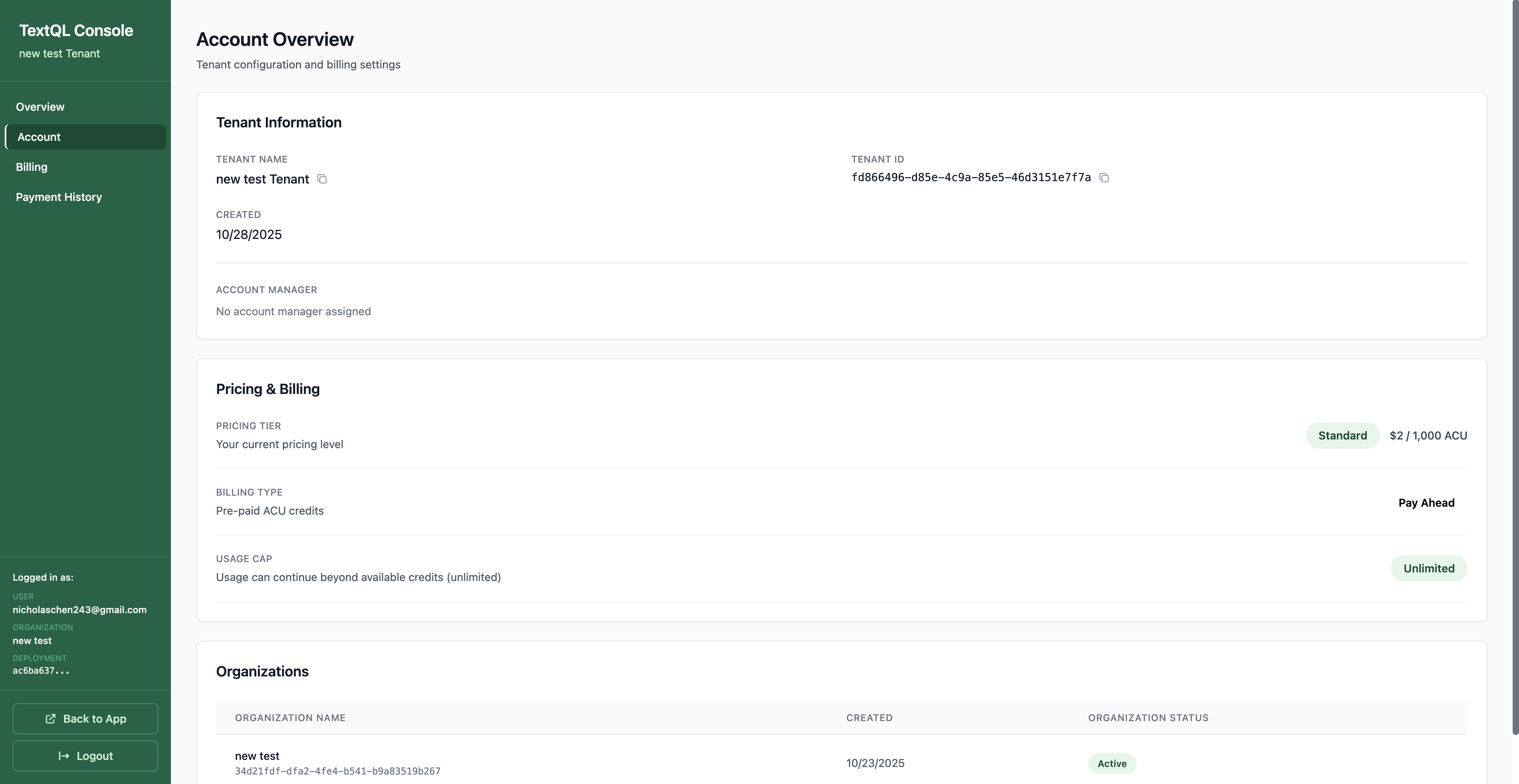
Pay Ahead payment method in Account settings
- In the Billing & Payments page, click the Add ACU Credits tab
- Scroll to Automatic Top-Up and click Set Up Automatic Top-Up
- Configure your balance threshold, top-up amount, payment method, and safety limits (max charges per day)
- Click Enable Automatic Top-Up
2. Auto-Invoice (Invoicing in Arrears)
Receive two invoices every month for predictable billing cycles:- Overage Invoice: Any usage beyond your subscription allotment from the previous month
- Subscription Invoice: Your upcoming month’s subscription allotment
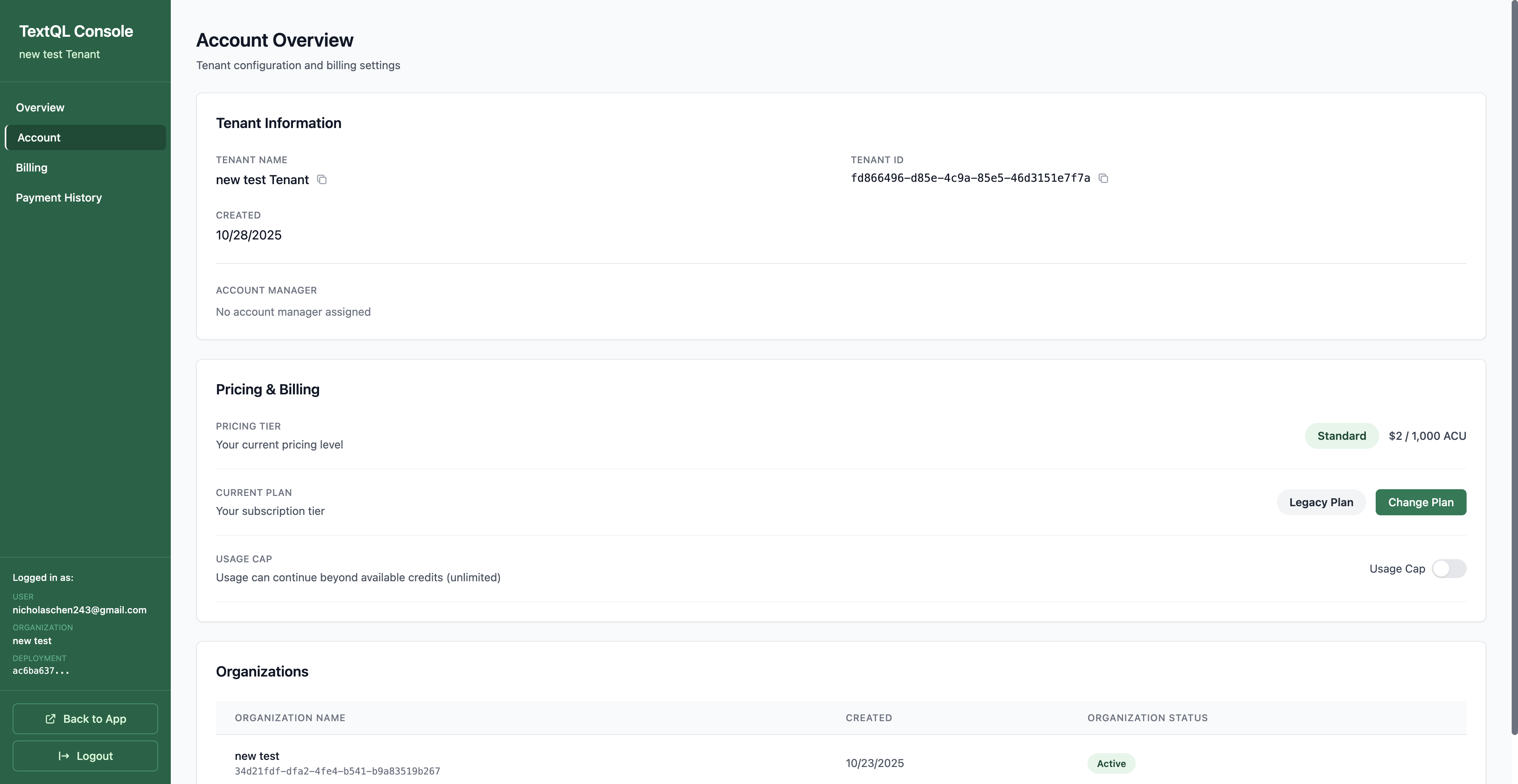
Auto-Invoice billing type in Account settings
- Enable Overages: Continue using ACUs beyond your monthly allotment. You’ll be invoiced for any overages at the end of the month.
- Enable Auto-Payment: Add a credit card to automatically charge both your subscription and overages, eliminating manual invoice processing
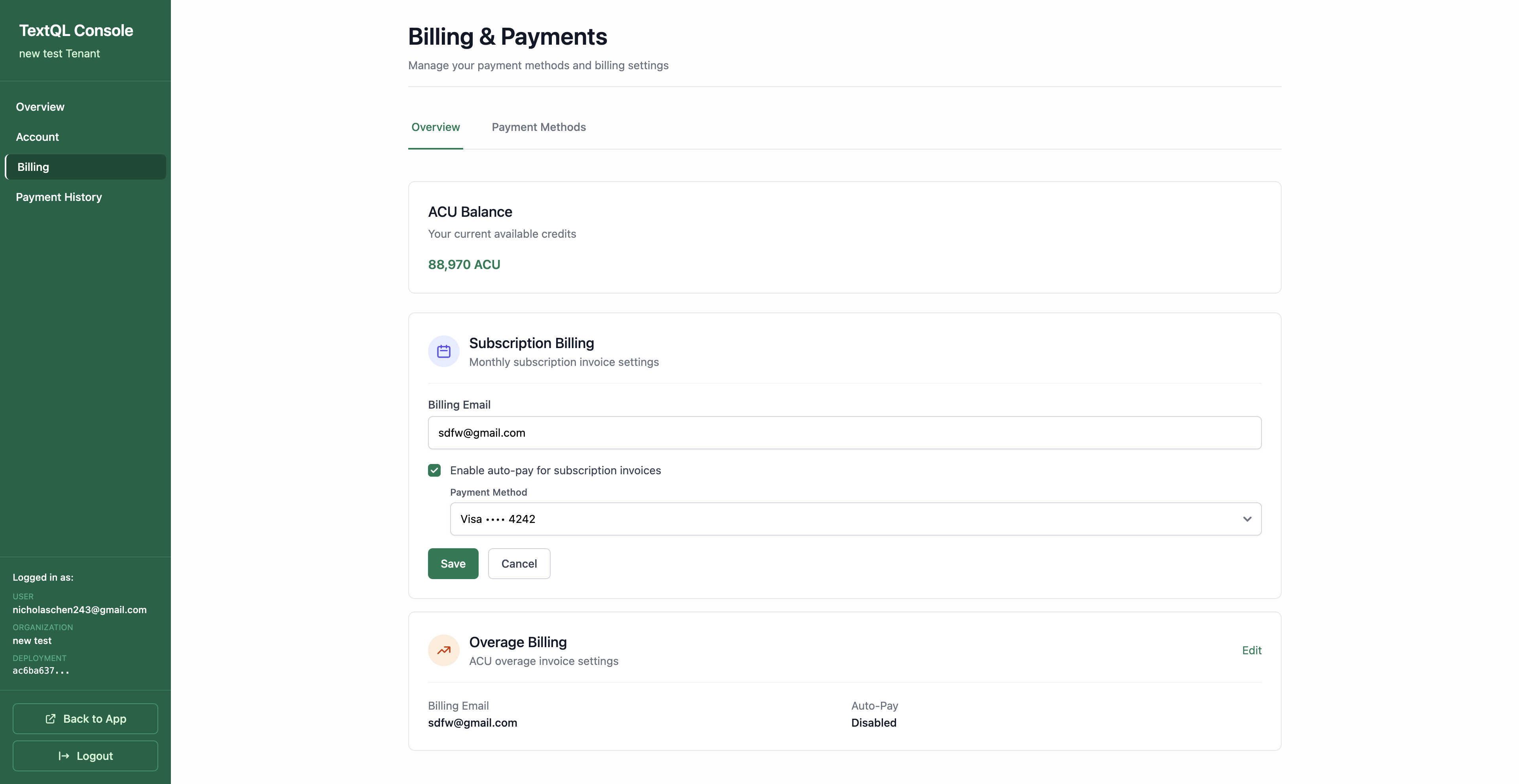
Auto-Invoice Billing page
3. Managed Invoice (Enterprise)
Your dedicated TextQL account manager handles all invoice details and administration through the platform.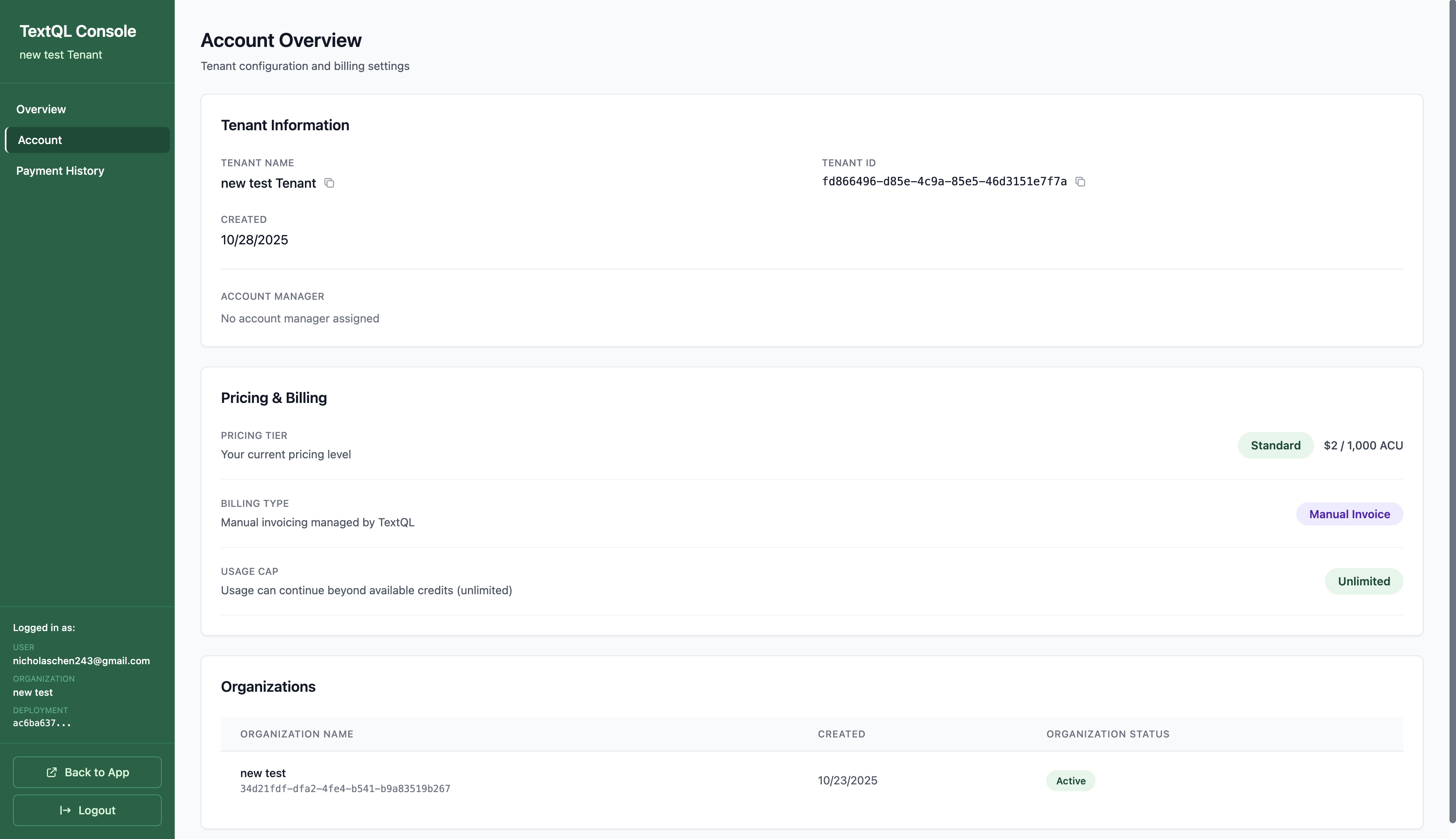
Managed Invoice billing type in Account settings
- Managed Administration: Your account manager inputs invoice details and manages billing
- Platform-Delivered Invoices: All invoices are issued through the TextQL platform
- Dedicated Support: Direct relationship with your account management team
Credit Card Payments
TextQL accepts all major credit cards for convenient and secure payment processing. Accepted Cards:- Visa
- Mastercard
- American Express
- Discover
- Click Billing in the sidebar
- Click Add Payment Methods
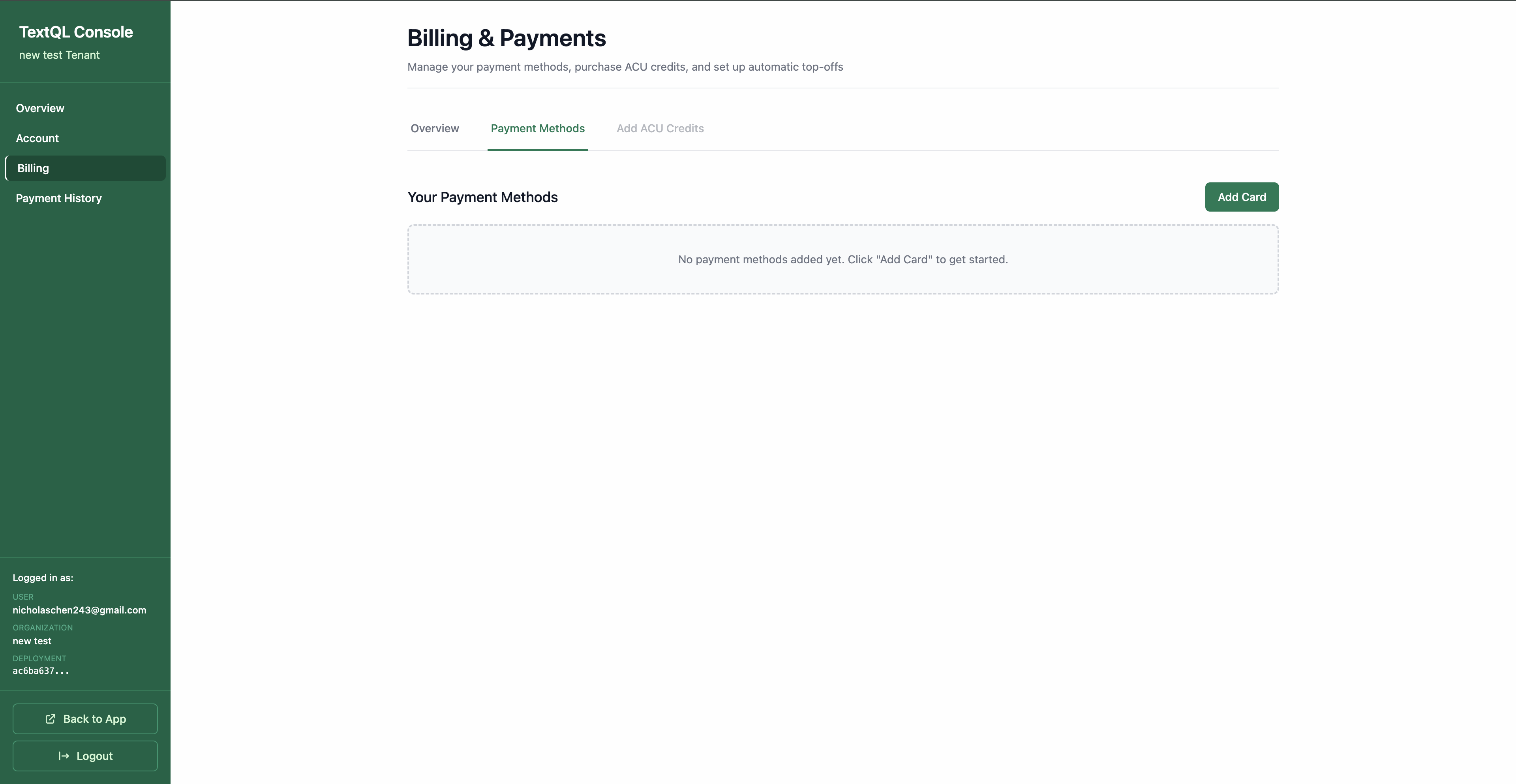
Payment Methods tab in Billing & Payments
- Click Add Card (if no other payment method is currently saved)
- Enter your card details:
- Card number
- Expiration date (MM/YY)
- CVV/security code
- Billing address (must match the address on file with your card issuer)
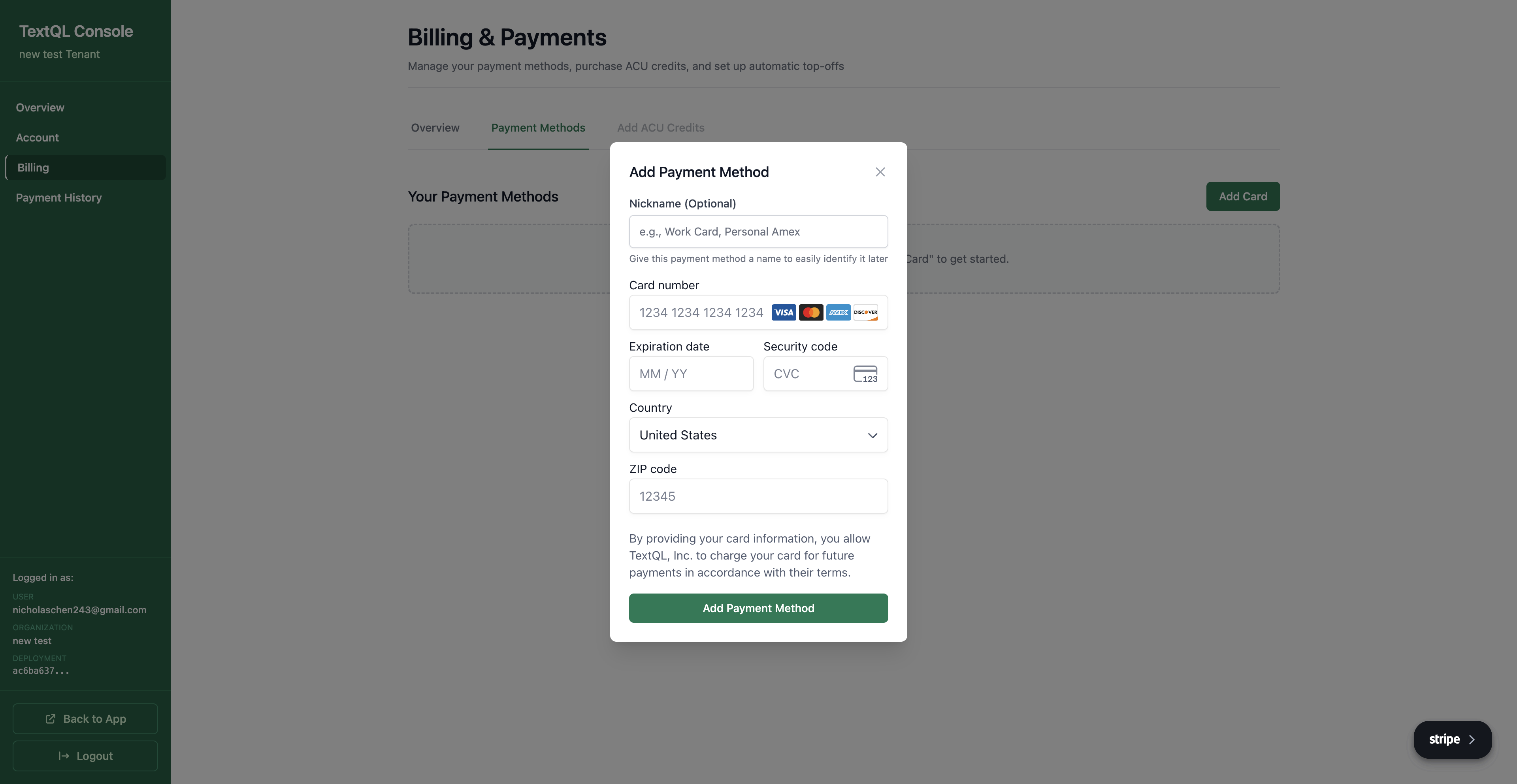
Add Card dialog
- Click Save Card to securely store your payment method — your card will now appear in the payment methods list
- Click the Add ACU Credits tab
- Enter the Amount (USD) you want to purchase (min $10, max $10,000)
- The system will display:
- How many ACUs you will receive
- The rate per ACU
- Your new balance after purchase
- Select your Payment Method from the dropdown
- Click Purchase [X] ACU for $[amount] to complete the transaction
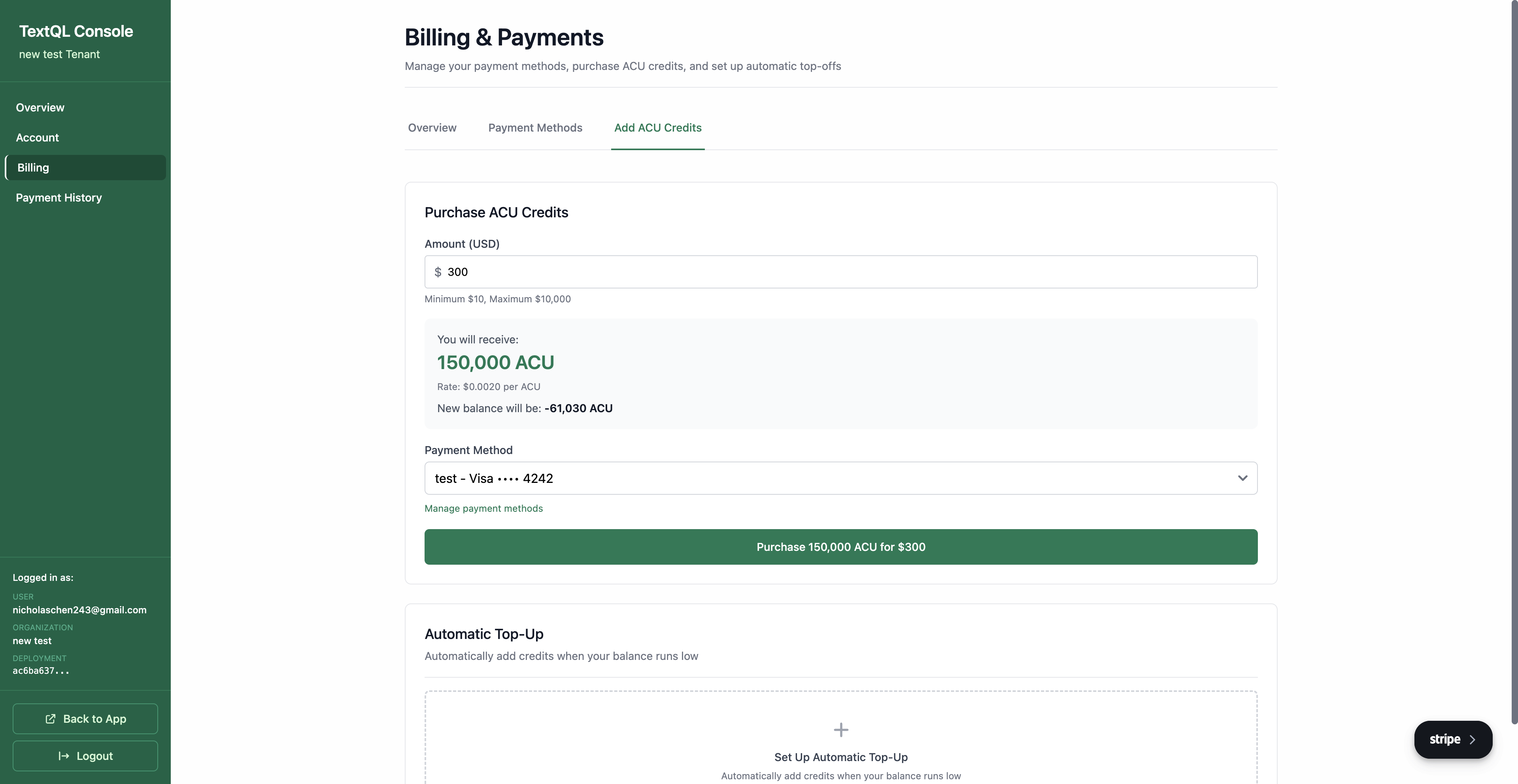
Purchase ACU Credits
Payment History & Invoices
You can view your complete payment history and invoices by clicking Payment History in the sidebar.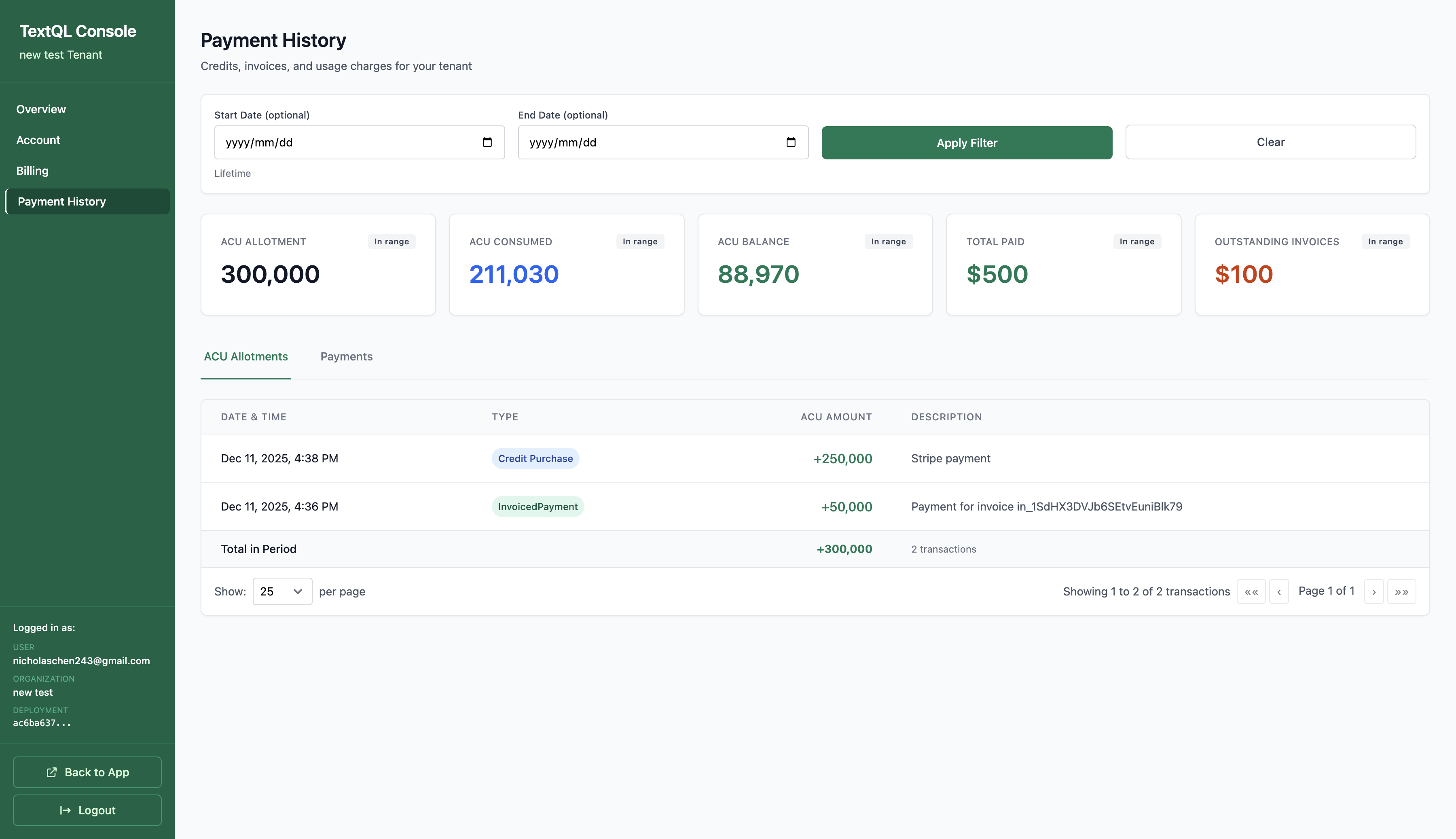
Payment History page
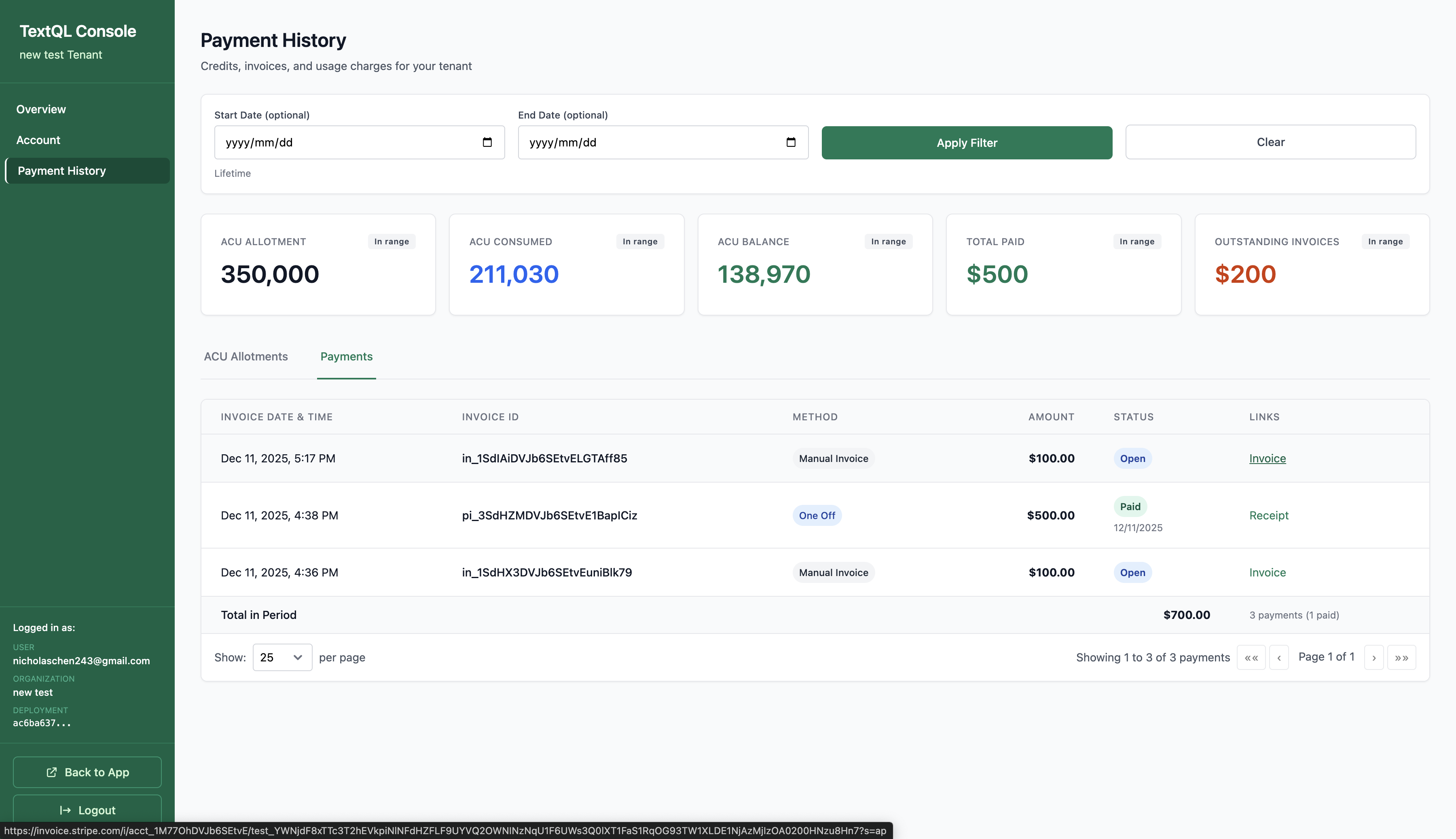
View Invoice details
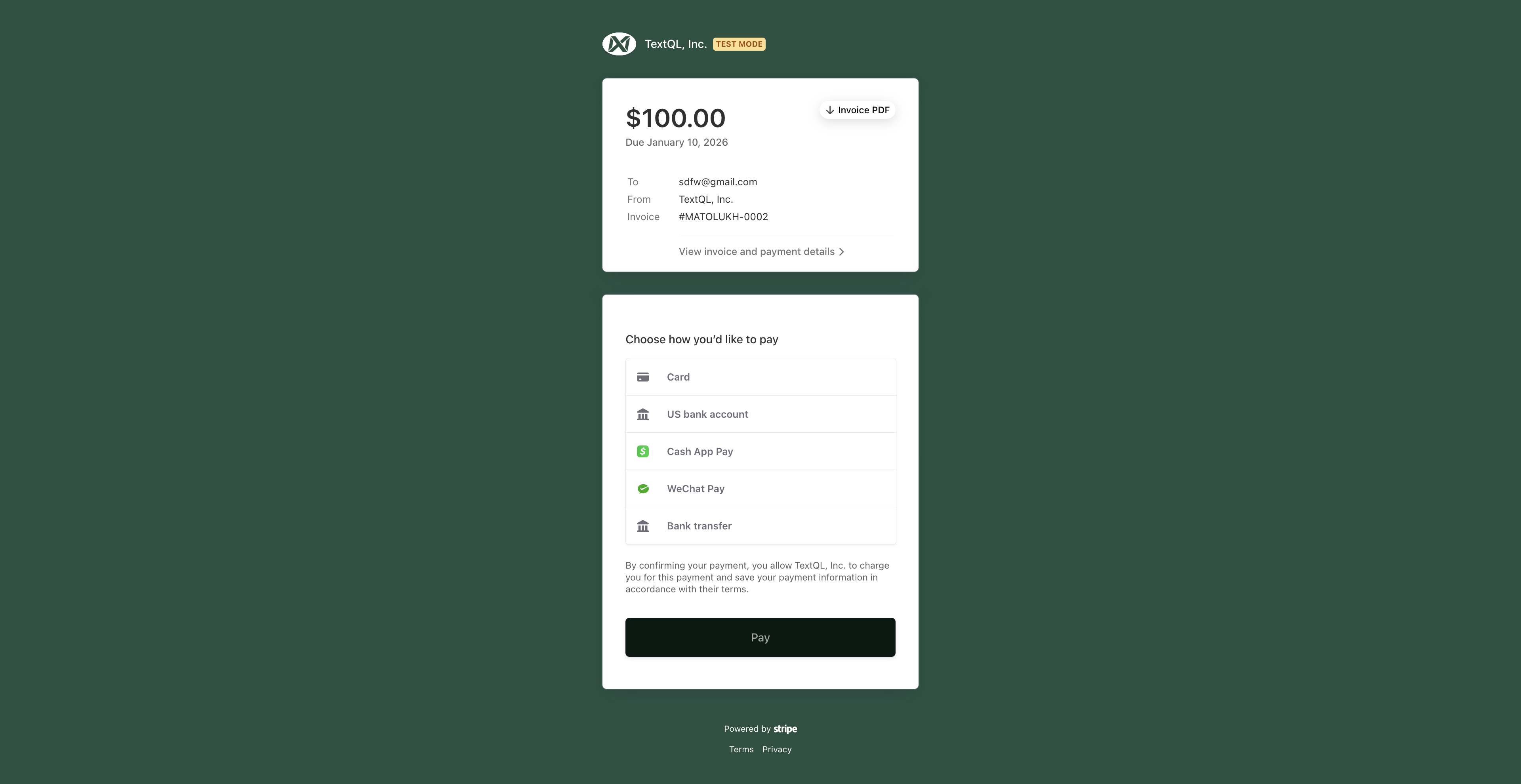
Stripe Invoice
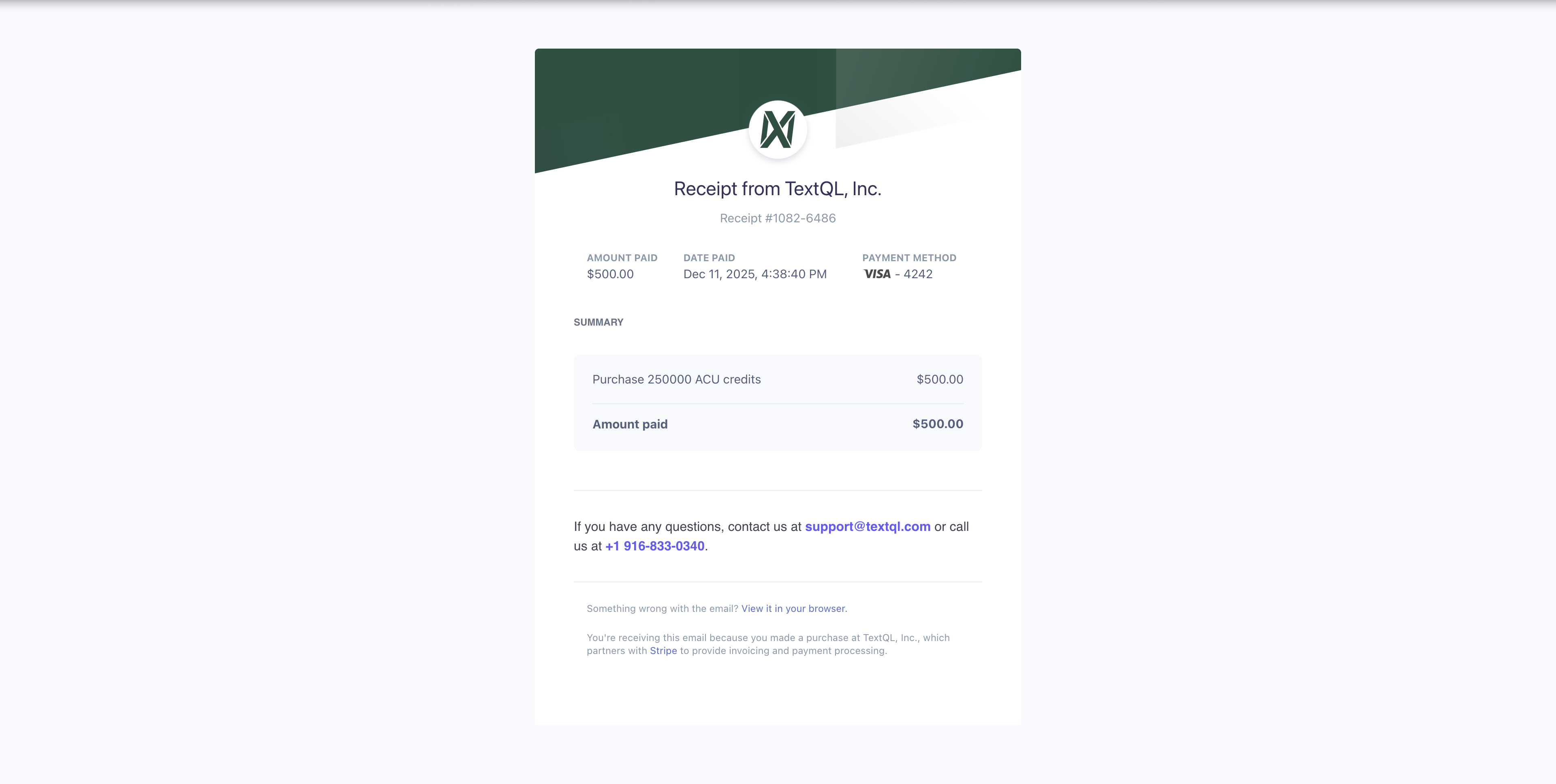
Stripe Receipt
Changing Your Plan
To change your subscription plan, go to Account and click the Change Plan button under Pricing & Billing.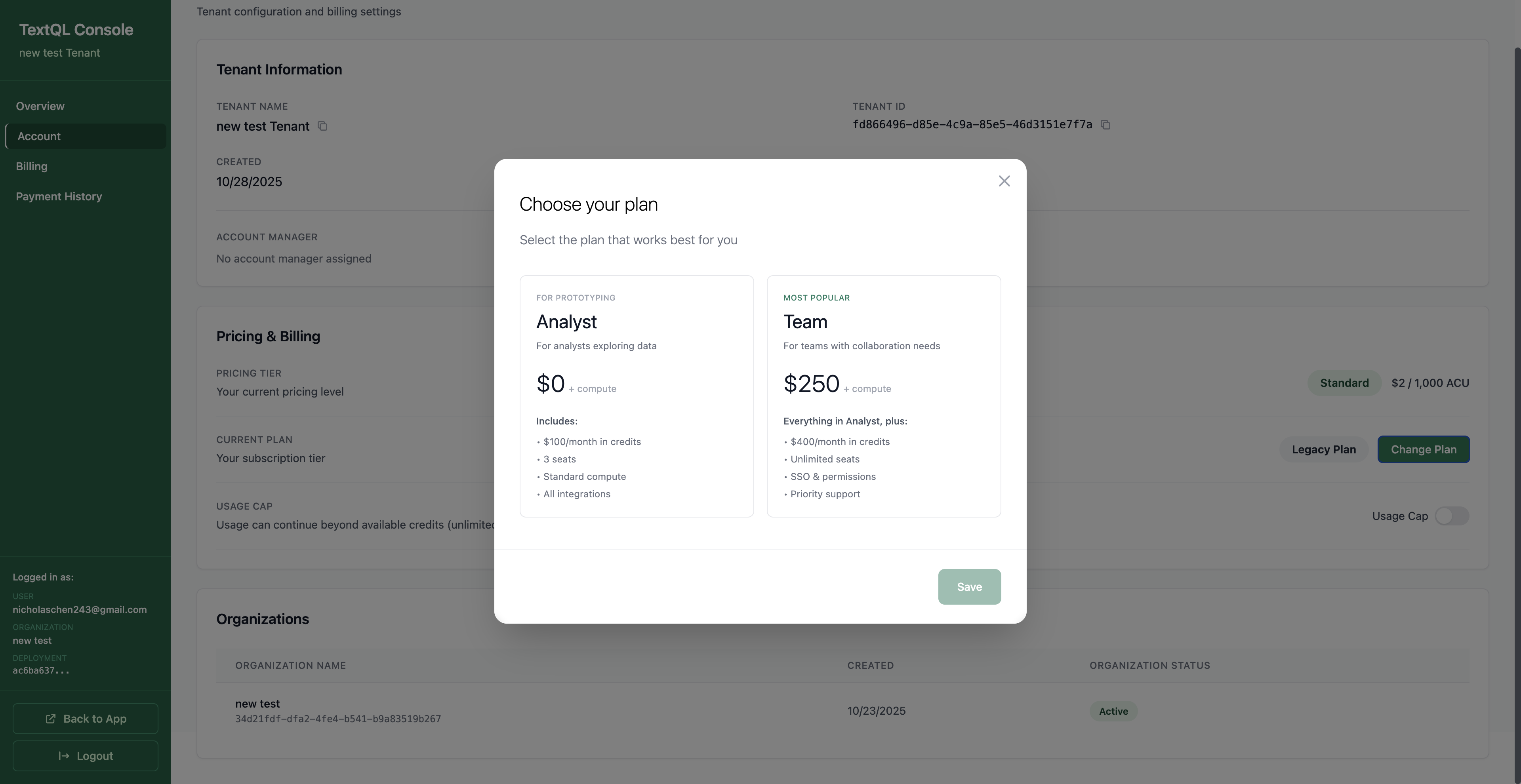
Change Plan
Compute
Instance Consumption Rate| Instance-Hour | ACUs Consumed |
|---|---|
| 1 hour | 500 |
Inference
AI Inference Pricing (ACUs per 1M Tokens). All inference pricing is denominated in ACUs per 1 million tokens processed.Claude Models
| Model | Token Range | Input | Cache Read | Ephemeral Cache | Persistent Cache | Output |
|---|---|---|---|---|---|---|
| MODEL_HAIKU_3 | N/A | 137.5 | 16.5 | 165 | 275 | 687.5 |
| MODEL_HAIKU_3_5 | N/A | 440 | 44 | 550 | 880 | 2,200 |
| MODEL_SONNET_3_5 | N/A | 1,650 | 165 | 2,062.5 | 3,300 | 8,250 |
| MODEL_SONNET_3_7 | N/A | 1,650 | 165 | 2,062.5 | 3,300 | 8,250 |
| MODEL_SONNET_4 | ≤200K | 1,650 | 165 | 2,062.5 | 3,300 | 8,250 |
| MODEL_SONNET_4 | >200K | 3,300 | 330 | 4,125 | 6,600 | 12,375 |
| MODEL_SONNET_4_5 | ≤200K | 1,650 | 165 | 2,062.5 | 3,300 | 8,250 |
| MODEL_SONNET_4_5 | >200K | 3,300 | 330 | 4,125 | 6,600 | 12,375 |
| MODEL_OPUS_4 | N/A | 8,250 | 825 | 10,312.5 | 16,500 | 41,250 |
OpenAI GPT Models
| Model | Token Range | Input | Cache Read | Output |
|---|---|---|---|---|
| MODEL_GPT_4 | N/A | 16,500 | N/A | 33,000 |
| MODEL_GPT_4_TURBO | N/A | 5,500 | N/A | 16,500 |
| MODEL_GPT_4O | N/A | 1,375 | 687.5 | 5,500 |
| MODEL_GPT_4O_MINI | N/A | 82.5 | 41.25 | 330 |
| MODEL_GPT_4_1 | N/A | 1,100 | 275 | 4,400 |
| MODEL_GPT_4_1_MINI | N/A | 220 | 55 | 880 |
| MODEL_GPT_4_1_NANO | N/A | 55 | 13.75 | 220 |
OpenAI O-Series Models
| Model | Token Range | Input | Cache Read | Output |
|---|---|---|---|---|
| MODEL_O_1 | N/A | 8,250 | 4,125 | 33,000 |
| MODEL_O_1_MINI | N/A | 605 | 302.5 | 2,420 |
| MODEL_O_3 | N/A | 1,100 | 275 | 4,400 |
| MODEL_O_3_MINI | N/A | 605 | 302.5 | 2,420 |
| MODEL_O_4_MINI | N/A | 605 | 151.25 | 2,420 |
Other Models
| Model | Token Range | Input | Cache Read | Output |
|---|---|---|---|---|
| MODEL_KIMI_K2_INSTRUCT | N/A | 330 | N/A | 1,375 |
| MODEL_QWEN3_CODER | N/A | 247.5 | N/A | 990 |
| MODEL_QWEN3_CODER_SMALL | N/A | 82.5 | N/A | 330 |
| MODEL_GPT_OSS | N/A | 82.5 | N/A | 330 |
| MODEL_GPT_OSS_SMALL | N/A | 38.5 | N/A | 165 |
Additional Services
Included Services. TextQL includes several essential services at no additional ACU cost to ensure seamless platform operations.| Service Category | Type | ACUs / Unit | Notes |
|---|---|---|---|
| Storage | Standard | 0 / GB / month | Persistent storage for your data and configurations |
| Connectivity | Ingress | 0 / GB | Data transfer into TextQL |
| Connectivity | Egress | 0 / GB | Data transfer out of TextQL |
| Tools | Web Search | 50 / search | Ana’s ability to search the web for real-time information |
This TextQL Virtual Sandcastle Service Consumption Table may be updated from time to time. Changes shall be effective on the date that TextQL announces they are effective. Any capitalized terms used but not defined herein shall have the meaning set forth in the Agreement or the Documentation, as applicable.